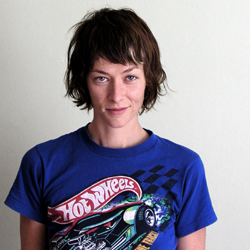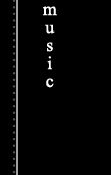




{bluebook} It is an inescapable truth that our individual histories color the compositions we create. In striving to generate solid conclusions, our primary battle often is the creation of meaning out of our tangled web of experience. For Denver’s Julie Davis, the textures of her life have overlapped neatly in her prismatic personal history. But this is not to say that her conclusions have come without ambition and purpose. No, the path that Davis has carved in the snowy fields of her evolution is a near-thesis on the power of integration and the endurance involved in our search for meaning. Haunting but spiritualized with breathy incantations that picture life as a conversation, Julie Davis' musical act, bluebook, is one of the Queen City’s most provocative and stunning music acts. The accomplished sound is predicated on the cadence of words and the choices within our daily diction. In this kind of landscape, bluebook is a collage of light and color. For Davis, bluebook is a continuous spiral upward – with her music mimicking this airy flight. Arousing on account of its ethereal but rich textures, and its ability to elevate an entire room to a transcendental breath, be sure: bluebook is that kind of musical experience which possesses enough power to lift all willing hands and heads into the heavens above. But, for Julie Davis, this striving for the heavens is by no means a new thing. At an early age Davis found her solace in a lofty rope swing. Here she sang and dipped her head in the clouds. Around family, reciting Robert Louis Stevenson poems was always part of her repertore. And the ambition only grew when Davis became involved with the Colorado Springs Children’s Chorale and began playing the flute. From there, Davis' became heavily involved in performing arts in her adolescence and that ascended into a love for old Jazz standards and torch songs. She later transitioned into a theater scholarship at a Northwest college and then graduate school, where she studied religion and literature. In her alchemical process of welding so many different disciplines together, Davis has managed to forge an altogether unique ideology and passion for being active in the world. Davis has always seen herself as a creature that seeks meaning in the natural and rational world. And coming from the Christological confines of Colorado Springs where she spent her formative years, Davis has often used religion as a vehicle in her exploration of the world around her. Battling notions of truth and fact embedded in our cultural history, Davis came to find a religious approach that was more literary than it was dogmatic. And after spending time at Yale’s Divinity School studying the philosophy of religion and its literary underpinnings – Davis moved back to Colorado to teach. Through her studies, however, she never forgot about her history of performance and drive to pursue music. For Davis, aesthetics played a primary role in her evolution. In part it is what drew her to jazz music and created her passion for singing torch songs. In this Davis found a vision in the literary feel of performance – and that kind of texture and aesthetic that develops character. For Davis, that kind of texture was first illustrated in her mind, in a picture of the lighted stage, a smoky nightclub, and a red velvet dress. For Davis those old jazz standards and the lessons embedded within them are as rich and poignant as religion. In fact, there may be no division between them. And so, it was no surprise that, upon arriving back from the East Coast and her religious studies, Davis began pursuing her old love: music and performance. This time, however, it took a new form. Instead of merely singing, Davis craved something else. She wanted to step further into a band, instead of standing out front. In this she choose an unorthodox instrument, especially for a vocalist: the stand-up bass. And as seems to be the case for most of Davis’ decisions, the drive to play bass flirted with the aesthetics of place and time – of the bass. Davis saw the stand-up as not only a something wildly different to play as a female vocalist, but philosophically – as a counterbalance to the top melody. The perfect embodiment of a clock and the rhythm of time, clicking and popping. And so she did as she has; she pursued with a fiery drive. And soon Davis was finding an aptitude for picking-up old jazz standards on the bass. Soon her evolution turned a corner and she began writing her own material. In this process, Davis realized that the old jazz aesthetic has passed, and that those old smoky nightclubs were part of our sepia past. So Davis pushed forward. Once again with integration and combination as the catalyst. Coupling from her musical interests with necessity, Davis melded the organic bass with electronic beats and samples. In this, Davis began formulating a truly individualistic vision. In the same way that she found importance in literary interpretation of religious works, Davis began to draw-out her vision of the world around her; the work that she needed to do. Throughout 2005-2006, Davis began a therapeutic project that soon became her first album. On account of her job as a tutor, she spent most of her days driving. And so she used a Dictaphone as her sketchbook: She put together arrangements and beats and lyrics in her car. She would constantly rewind the tape, playing with the textures and movements. Then, once home – she transferred her compositions onto tape. For Davis, inspiration comes from the individual’s propulsion through life. Life is the image. The interpretation and reflection is the religion. In accord with this notion, bluebook’s first album was composed of the cadences of life and those practical elements that we all take for granted – but which elements are still the vertebrate of existence. To tell her tale and create her poetic oeuvre, Davis explored such unsung components to our daily life as the margin and the white line on the side of the road; the one we are ceaselessly following, day-in and day-out. And while that white line runs forward – out and away, defining the path of our life – everything, absolutely everything comes back to our personal histories. And so while Davis was ardently composing pieces of music that were expanding on the historical modes of jazz, she was always reaching into her past and combining the elements of her road. In her upcoming album (due out Spring 2007) we can find Davis once again back on her childhood rope swing, singing and reciting her favorite poems. Dickinson, Cummings, and T.S. Eliot’s “Preludes” will be the primary players in her musical landscape – coloring her light and assisting in her exhibition on the cadence of life. Currently recording at Helmet Room, this album promises to be an exciting contribution to the much-anticipated catalogue of upcoming Denver releases. Now with a full band, bluebook continues to progress. With Mike Hall (Born in the Flood), Brigid McAuliffe (Pee Pee) and Carrie Beeder (The Wheel and Porlolo), Davis’ compositions are sure to continue to grow. By adding the cast of musicians Davis has once again thrust herself into that place of integration. Just as she did when she decided to pickup the bass – Davis is playing with the notion of personal growth and the quest for meaning in her taking-on a full band. Surely Davis will be undergoing yet another growing spurt. On stage you can see it: the theater is Julie Davis’ ministry, her place of religion. At all times grateful for what it is that she has created – you can feel it leeching-out into your pores, pushing us onward as that great leaving song which bellows across the theater with the boom of Eliot’s “The Love Song of J. Alfred Prufrock”: “Let us go then, you and I, When the evening is spread out against the sky… …Till human voices wake us, and we drown.” www.myspace.com/bluebook |









